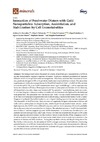Identificador persistente para citar o vincular este elemento:
https://accedacris.ulpgc.es/handle/10553/41362
| Título: | Interaction of freshwater diatom with gold nanoparticles: adsorption, assimilation, and stabilization by cell exometabolites | Autores/as: | Gonzalez, Aridane G. Pokrovsky, Oleg S. Ivanova, Irina Oleinikova, Olga Feurtet-Mazel, Agnes Mornet, Stephane Baudrimont, Magalie |
Clasificación UNESCO: | 2510 Oceanografía | Palabras clave: | AuNPs Freshwater diatoms Biofilm Adsorption River, et al. |
Fecha de publicación: | 2018 | Publicación seriada: | Minerals | Resumen: | The rising concern about the potential toxicity of synthetic gold nanoparticles (AuNPs) in aquatic environments requires a rigorous estimation of physico-chemical parameters of reactions between AuNPs and major freshwater microorganisms. This study addresses the interaction of 10-nm size, positively charged AuNPs with periphytic freshwater diatoms (Eolimna minima). The adsorption experiments on viable cells were performed in 10 mM NaCl and 5 mM NaCl + 5mMNaHCO(3) solution at a variable pH (3-10), at an AuNPs concentration from 1 mu g/L to 10,000 mu g/L, and an exposure time from a few minutes to 55 days. Three types of experiments, adsorption as a function of time (kinetics), pH-dependent adsorption edge, and constant-pH "Langmuirian" type isotherms, were conducted. In addition, long-term interactions (days to weeks) of live diatoms (under light and in the darkness) were performed. The adsorption was maximal at a pH from 3 to 6 and sizably decreased at a pH of 6 to 10. Results of adsorption experiments were modeled using a second order kinetic model, a Linear Programming Model, Freundlich isotherm, and a ligand binding equation for one site competition. The adsorption of AuNPs(+) most likely occurred on negatively-charged surface sites of diatom cell walls such as carboxylates or phosphorylates, similar to previously studied metal cations. Under light exposure, the AuNPs were stabilized in aqueous solution in the presence of live cells, probably due to the production of exometabolites by diatoms. The adsorbed amount of AuNPs decreased after several days of reaction, suggesting some AuNPs desorption. In the darkness, the adsorption and assimilation were stronger than under light. Overall, the behavior of positively charged AuNPs at the diatom-aqueous solution interface is similar to that of metal cations, but the affinity of aqueous AuNPs to cell exometabolites is higher, which leads to the stabilization of nanoparticles in solution in the presence of diatoms and their exudates. During photosynthetic activity and the pH rising above 9 in the vicinity of diatom cells, the adsorption of AuNPs strongly decreases, which indicates a decreasing potential toxicity of AuNPs for photosynthesizing cells. The present study demonstrates the efficiency of a thermodynamic and kinetic approach for understanding gold nanoparticles interaction with aquatic freshwater peryphytic microorganisms. | URI: | https://accedacris.ulpgc.es/handle/10553/41362 | ISSN: | 2075-163X | DOI: | 10.3390/min8030099 | Fuente: | Minerals [ISSN 2075-163X], v. 8 (3), p. 99 |
| Colección: | Artículos |
Citas SCOPUSTM
4
actualizado el 30-mar-2025
Citas de WEB OF SCIENCETM
Citations
4
actualizado el 30-mar-2025
Visitas
79
actualizado el 30-sep-2023
Descargas
97
actualizado el 30-sep-2023
Google ScholarTM
Verifica
Altmetric
Comparte
Exporta metadatos
Los elementos en ULPGC accedaCRIS están protegidos por derechos de autor con todos los derechos reservados, a menos que se indique lo contrario.
